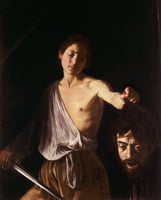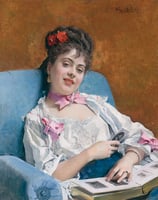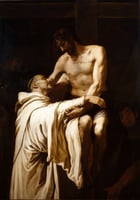Caravaggio (1571–1610) was an Italian painter known for his dramatic use of chiaroscuro (the...
The Mastery of Light in Caravaggio's Artwork

Explore the revolutionary use of light in Caravaggio's paintings that forever changed the course of art history.
Unveiling Caravaggio's Innovative Use of Chiaroscuro
Caravaggio's mastery of chiaroscuro not only revolutionized the art world but also transcended the boundaries of traditional painting techniques. By skillfully manipulating light and shadow, Caravaggio was able to breathe life into his subjects, creating a sense of realism and depth that was unparalleled in his time.
His innovative use of chiaroscuro not only added visual interest to his compositions but also served a deeper purpose in conveying the emotional and psychological states of his characters. Through the strategic placement of light and shadow, Caravaggio was able to evoke a wide range of sentiments, from joy and serenity to fear and despair, drawing viewers into the narrative with unparalleled intensity.
Furthermore, Caravaggio's unique approach to lighting not only captivated the art world of his time but also laid the foundation for future generations of artists. His bold experimentation with chiaroscuro paved the way for a new era of artistic expression, inspiring countless artists to explore the interplay of light and shadow in their own work.
In essence, Caravaggio's use of chiaroscuro was not simply a stylistic choice but a revolutionary technique that forever changed the course of art history. His ability to harness the power of light and shadow to convey emotion, symbolism, and psychology set him apart as a true master of his craft, leaving behind a legacy that continues to influence and inspire artists to this day.
Deciphering the Symbolism of Light and Shadow in Caravaggio's Work
Caravaggio's profound understanding of light and shadow transcends the realm of mere artistic techniques, delving deep into the intricate tapestry of symbolism and meaning. The interplay between light and dark in his paintings serves as a visual metaphor for the eternal conflict between opposing forces such as good and evil, the sacred and the profane, or enlightenment and ignorance. Through the strategic placement of light sources within his compositions, Caravaggio skillfully conveys themes of spiritual enlightenment and moral quandaries that resonate with viewers on a profound and introspective level.
A prime example of this symbolism can be observed in 'The Calling of Saint Matthew', where the divine shaft of light that bathes Matthew's face symbolizes the intervention of a higher power in his earthly existence. This poignant imagery not only captures the moment of revelation but also prompts contemplation on the deeper theological and philosophical underpinnings of Caravaggio's oeuvre. Through his expert manipulation of light and shadow, Caravaggio beckons us to ponder the complexities of human existence and the eternal struggle between the forces of illumination and obscurity.
The Psychological Impact of Lighting in Caravaggio's Paintings
Caravaggio's use of light in his paintings goes far beyond mere illumination; it serves as a potent tool that delves deep into the psyche of his subjects, revealing the emotional and psychological depths of their characters.
Heightening Emotional Intensity
In works such as "Judith Beheading Holofernes," Caravaggio's strategic manipulation of light and shadow intensifies the emotional intensity of the scene. The stark contrast between light and dark serves to underscore the tension and brutality of the moment, emphasizing Judith's unwavering determination in the face of a daunting task. The harsh illumination of the figures against the deep shadows creates a sense of urgency and drama, drawing viewers into the narrative with visceral impact.
Inviting Interpretation and Engagement
The enigmatic quality of shadows in Caravaggio's artworks adds an element of intrigue and mystery, inviting viewers to engage with the innermost thoughts and emotions of the figures portrayed. By obscuring certain details in shadow while highlighting others in light, Caravaggio creates a sense of ambiguity and complexity that encourages interpretation and reflection. Viewers are prompted to immerse themselves in the psychological drama unfolding on the canvas, grappling with the conflicting emotions and motivations of the characters depicted.
Transcending Time and Space
This interplay of light and psychology weaves a mesmerizing narrative that transcends time, drawing audiences into a realm where the lines between reality and imagination blur seamlessly. Caravaggio's expert manipulation of light not only captures the external beauty of his subjects but also reveals the intricate complexities of the human experience. By tapping into universal themes of love, betrayal, and redemption, Caravaggio's paintings resonate across generations, speaking to the timeless truths of the human condition.
Inspiring Reflection and Contemplation
Caravaggio's use of lighting invites viewers to contemplate the deeper meaning behind his works, prompting reflection on the nature of morality, power, and identity. The interplay of light and shadow becomes a metaphor for the dualities of existence, inviting viewers to explore the complexities of the human psyche. Through his masterful manipulation of light, Caravaggio invites us to confront our own inner demons and wrestle with the existential questions that define the human experience.
Leaving a Profound and Enduring Impact
In conclusion, Caravaggio's expert use of lighting in his paintings leaves a profound and enduring impact on viewers, transcending the boundaries of time and space. Through his masterful manipulation of light and shadow, Caravaggio reveals the emotional and psychological depths of his subjects, inviting viewers to engage with the profound truths of the human condition. His paintings continue to captivate and inspire audiences across generations, reminding us of the enduring power of art to illuminate the complexities of existence.
Comparing Caravaggio's Technique to His Contemporaries
Caravaggio's departure from the traditional artistic norms of his time not only set him apart from his contemporaries but also ignited a revolution in the art world. While artists like Annibale Carracci and Domenichino adhered to the classical approach of evenly lit compositions, Caravaggio fearlessly challenged the status quo by opting for a raw and emotionally charged depiction of life.
His groundbreaking use of chiaroscuro not only captured the physical forms of his subjects but also delved deep into their innermost beings, infusing his paintings with a sense of realism and intensity that was unparalleled. This bold departure from the norm not only established Caravaggio as a true innovator but also laid the groundwork for a new artistic movement known as Tenebrism, characterized by its extreme use of light and shadow to convey powerful narratives.
The 'Caravaggisti', devoted followers of Caravaggio's revolutionary style, enthusiastically embraced this new approach, carrying forward his legacy and pushing the boundaries of artistic expression even further. Through their collective body of work, they continued to explore the profound emotional and psychological impact of light, further cementing Caravaggio's enduring influence on the art world for generations to come.
Unveiling Caravaggio's Innovative Use of Chiaroscuro
Caravaggio's mastery of chiaroscuro not only revolutionized the art world but also transcended the boundaries of traditional painting techniques. By skillfully manipulating light and shadow, Caravaggio was able to breathe life into his subjects, creating a sense of realism and depth that was unparalleled in his time.
Revolutionizing Artistic Techniques
Caravaggio's innovative use of chiaroscuro was not merely a stylistic choice but a revolutionary technique that forever changed the course of art history. Unlike his contemporaries, who often depicted figures bathed in evenly distributed light, Caravaggio embraced a bold and dramatic approach, casting his subjects in stark contrast between light and shadow.
This daring departure from conventional techniques allowed Caravaggio to create compositions that were not only visually striking but also emotionally resonant. By highlighting certain features while obscuring others in shadow, he was able to draw viewers' attention to specific elements of the scene, guiding their gaze and evoking powerful emotional responses.
Conveying Emotional Depth
One of the most remarkable aspects of Caravaggio's use of chiaroscuro is its ability to convey profound emotional depth within his paintings. Through the strategic placement of light and shadow, Caravaggio was able to capture the complex inner workings of his subjects' minds, revealing their innermost thoughts and emotions to the viewer.
In works such as "The Supper at Emmaus" and "The Calling of Saint Matthew," Caravaggio's use of chiaroscuro serves to heighten the drama and intensity of the scenes, imbuing them with a sense of urgency and immediacy. The stark contrast between light and shadow creates a dynamic interplay of emotions, allowing viewers to empathize with the figures depicted on the canvas.
Inspiring Future Generations
Caravaggio's bold experimentation with chiaroscuro paved the way for a new era of artistic expression, inspiring countless artists to explore the interplay of light and shadow in their own work. His innovative approach to lighting not only captivated the art world of his time but also laid the foundation for future generations of artists to build upon.
Throughout the centuries, artists have continued to draw inspiration from Caravaggio's revolutionary techniques, incorporating chiaroscuro into their own artistic practices. From the dramatic lighting of film noir to the atmospheric effects of modern photography, Caravaggio's legacy lives on in the visual storytelling of today.
Deciphering Symbolism and Narrative
Beyond its technical mastery, Caravaggio's use of chiaroscuro also serves a deeper symbolic and narrative purpose. The contrast between light and shadow becomes a metaphor for the eternal struggle between good and evil, enlightenment and ignorance, or life and death.
In works such as "The Conversion of Saint Paul" and "The Martyrdom of Saint Matthew," Caravaggio's use of chiaroscuro not only enhances the drama of the scenes but also underscores their underlying themes of divine intervention and spiritual enlightenment. Through his masterful manipulation of light and shadow, Caravaggio invites viewers to contemplate the deeper philosophical and theological implications of his work.
In essence, Caravaggio's innovative use of chiaroscuro represents a watershed moment in the history of art, forever changing the way artists approach the depiction of light and shadow. His ability to harness the power of chiaroscuro to convey emotion, symbolism, and psychology set him apart as a true master of his craft, leaving behind a legacy that continues to influence and inspire artists to this day.
Caravaggio's Legacy: Influencing Modern Photography and Cinema
Caravaggio's revolutionary use of light not only left a lasting impact on the Baroque period but also transcended centuries, influencing modern visual storytelling mediums such as photography and cinema.
Transforming Visual Storytelling
The dramatic chiaroscuro techniques employed by Caravaggio have become a staple in the toolkit of cinematographers and photographers, allowing them to create mood, direct focus, and convey emotions with unparalleled depth and intensity. Just as Caravaggio's paintings drew viewers into immersive worlds of light and shadow, modern filmmakers and photographers utilize similar techniques to guide audiences on emotional journeys.
Acknowledgement from Renowned Directors
Renowned directors like Martin Scorsese and Vittorio Storaro have openly acknowledged Caravaggio's profound influence on their work, citing his mastery of light and shadow as a source of inspiration. The legacy of Caravaggio extends far beyond the confines of the canvas, permeating contemporary visual arts and guiding artists in manipulating light to evoke powerful emotional responses from their audiences.
Crafting Compelling Narratives
By studying Caravaggio's innovative approach to lighting, modern visual artists continue to learn how to craft compelling narratives through the strategic use of chiaroscuro. The interplay of light and shadow becomes a powerful storytelling tool, allowing artists to convey mood, evoke emotion, and guide the viewer's gaze. Just as Caravaggio used light to reveal the inner workings of his subjects' minds, today's artists use similar techniques to delve into the complexities of human experience.
Perpetuating Caravaggio's Legacy
Caravaggio's legacy lives on in the visual storytelling of today, reminding us of the enduring power of light in shaping our perception of the world. Whether on the silver screen or in the pages of a magazine, the influence of Caravaggio's chiaroscuro can be seen in every frame, guiding viewers on emotional journeys and inviting them to contemplate the mysteries of existence. As long as artists continue to harness the power of light and shadow, Caravaggio's legacy will endure, inspiring generations to come with its timeless beauty and profound insight.




